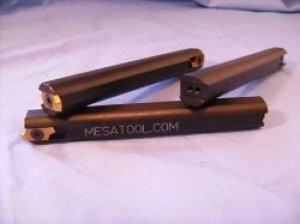- Joined
- Jul 2, 2014
- Messages
- 7,594
It is quite possible to use a boring bar with a threading tool mounted on the back side of the work, cutting side up, and run the spindle in reverse (clockwise), tool moves away from headstock. This will not work if the work piece is between centers with a standard tool post, or for threads over 4 1/2" diameter on my 13x40 lathe. This is not for long threads or threads a long distance from the right end of the work. It works great otherwise! The same setup works for boring away from an internal shoulder or face, but with the tool cutting on the near side of the bore, tool cutting edges facing down.


![20171030_080756[1].jpg 20171030_080756[1].jpg](https://www.hobby-machinist.com/data/attachments/202/202789-b745c939e97d8039f9e8dd2ed39326eb.jpg)